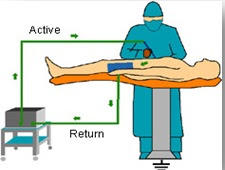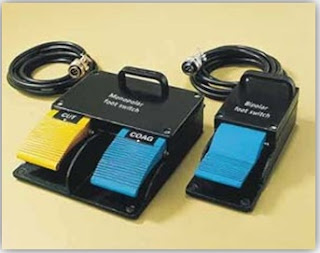What is the Electrosurgical unit?
An Electro Surgical Unit makes use of radiofrequency electrical current to cut, coagulate or destroy tissue. An electrosurgical unit is an instrument used in surgeries, where a high-frequency electric current is used to cut and coagulate tissues.
During surgery, there is significant blood loss as the tissues and blood vessels are cut resulting in bleeding. Thus the use of an electrosurgical unit reduces bleeding and loss of blood.
ESU circuit design is made to provide the correct electrical waveforms to be delivered to the site of surgery to coagulate blood vessels thus cutting tissues in a safe and smooth manner. A Surgeon may use the electrosurgery unit instead of, or in addition to a conventional scalpel.
When used properly, the electrosurgical unit has a less damaging effect on tissues than that of a scalpel and allows for a safe way to stop bleeding.
These electrosurgical equipment uses an electric current of an oscillating frequency of nearly 500 kHz to cut and coagulate tissues. When the electrical current is passed through the tissue, it gets heated up resulting in water evaporation which ultimately destroys cells. Thus, the process of cutting, clotting, dehydrating blood cells and tissues is achieved with minimal blood loss.
An alternating current enters into the patient’s that is part of the closed circuit consisting of a generator, an active electrode, patient, and the patient's return electrode.
The voltage on the electrode is between 1000 to 10000 Volts peak to peak. There are mainly three modes of functioning for the electronic surgical unit: cutting, coagulation, and blended mode.
Modes Of Operation Of an ESU
Cutting mode
The electric current divides tissues without coagulation. Then a lower voltage is required to achieve tissue vaporization. This requires 50 watts in the case of bipolar cut and around 150-300 watts in the case of a monopolar cut. Such mode is achieved with a continuous sinusoidal waveform.
Coagulation Mode
Blood clotting is achieved by burning the ends of vessels to control bleeding. This would require 80 watts in bipolar cut and 40-80 watts in the case of a monopolar cut. Coagulation mode is achieved primarily with a series of sinusoidal wave packets.
Modes of functioning
There are two modes; Monopolar and Bipolar. The main difference between the two modes is the method by which an electric current enters and exits human tissues.
Monopolar
Current flows through the patient to a patient return electrode.
The high current density in the area of active the electrode achieves either tissue cutting or tissue coagulation.
The low current density under the dispersive electrode causes no tissue damage which is used for cutting and coagulation respectively.

Monopolar Mode
Bipolar Mode

Bipolar mode
Active electrode and return electrode functions at the site of surgery(Forceps tines). Only the tissue grasped is included in the electrical circuit. (Current passes only between tips of forceps). Thus the patient does not need a return "dispersive" electrode. This mode is mainly used for coagulation.
Modes of Operation
There are three modes of operation and can be produced on command, dependent upon the waveform issued by the ESU.
Cutting Mode

A cutting mode in ESU
A high-frequency alternating current yield smooth, rapid cuts that evoke little to no homeostasis. The current stimulates cells to swell and explode.
Coagulation Mode

Coagulation mode in ESU
It is the sparking of tissues leading to coagulation. There is no tissue-electrode contact; rather, voltage is raised in order to incite a spark between electrodes in order to coagulate the tissue in between.
Blended Mode

A blended mode in ESU
It is a combined effect of cutting and coagulating; dampened waveform that produces some homeostasis during cutting.
Machine Block Diagram of a Typical ESU Block Diagram

ESU Block Diagram
If you are looking for more in-depth information you might want to visit the link provided as it contains more useful information related to ESU.
ESU Accessories
Monopole active electrodes

ESU: Monopolar Electrodes
Cut or coagulate control is from the pencil-like electrode or from a footswitch. The needle is disposable and changeable depending on the surface area required.
Bipolar Electrode

ESU: Bipolar Electrodes
Control of the coagulation is by a footswitch. So when activating the bipolar electrode, the monopole settings automatically shuts-off or are bypassed.
Dispersive Electrode

ESU: Dispersive / Grounding electrode
As mentioned before the dispersive electrodes are of very high importance as they are responsible for returning the current passing through the patient body safely back to the machine.
Foot Switch

ESU: Foot Switch
That is how an ESU might look like from the inside. For any ideas and comments please don't hesitate to write them in the comments section.
We highly recommend that you visit and sign up for advantage training and to be able to undergo training courses provided by Fluke Biomedical especially the one related to ESU session, you will be eligible for a system-generated certificate once you pass any course.
In case you have any comment don't hesitate to write it below!
What is the Electrosurgical unit?
An Electro Surgical Unit makes use of radiofrequency electrical current to cut, coagulate or destroy tissue. An electrosurgical unit is an instrument used in surgeries, where a high-frequency electric current is used to cut and coagulate tissues.
During surgery, there is significant blood loss as the tissues and blood vessels are cut resulting in bleeding. Thus the use of an electrosurgical unit reduces bleeding and loss of blood.
ESU circuit design is made to provide the correct electrical waveforms to be delivered to the site of surgery to coagulate blood vessels thus cutting tissues in a safe and smooth manner. A Surgeon may use the electrosurgery unit instead of, or in addition to a conventional scalpel.
When used properly, the electrosurgical unit has a less damaging effect on tissues than that of a scalpel and allows for a safe way to stop bleeding.
When used properly, the electrosurgical unit has a less damaging effect on tissues than that of a scalpel and allows for a safe way to stop bleeding.
These electrosurgical equipment uses an electric current of an oscillating frequency of nearly 500 kHz to cut and coagulate tissues. When the electrical current is passed through the tissue, it gets heated up resulting in water evaporation which ultimately destroys cells. Thus, the process of cutting, clotting, dehydrating blood cells and tissues is achieved with minimal blood loss.
An alternating current enters into the patient’s that is part of the closed circuit consisting of a generator, an active electrode, patient, and the patient's return electrode.
A transformer allows generating a high voltage to let the passage of high electric current that corresponds to the power required for surgical purposes.
The voltage on the electrode is between 1000 to 10000 Volts peak to peak. There are mainly three modes of functioning for the electronic surgical unit: cutting, coagulation, and blended mode.
Modes Of Operation Of an ESU
Cutting mode
The electric current divides tissues without coagulation. Then a lower voltage is required to achieve tissue vaporization. This requires 50 watts in the case of bipolar cut and around 150-300 watts in the case of a monopolar cut. Such mode is achieved with a continuous sinusoidal waveform.
Coagulation Mode
Blood clotting is achieved by burning the ends of vessels to control bleeding. This would require 80 watts in bipolar cut and 40-80 watts in the case of a monopolar cut. Coagulation mode is achieved primarily with a series of sinusoidal wave packets.
Modes of functioning
There are two modes; Monopolar and Bipolar. The main difference between the two modes is the method by which an electric current enters and exits human tissues.
Monopolar
Current flows through the patient to a patient return electrode.
The active electrode is in the wound and a patient return electrode is attached to the patient.
The high current density in the area of active the electrode achieves either tissue cutting or tissue coagulation.
The low current density under the dispersive electrode causes no tissue damage which is used for cutting and coagulation respectively.
 |
| Monopolar Mode |
Bipolar Mode
 |
| Bipolar mode |
Active electrode and return electrode functions at the site of surgery(Forceps tines). Only the tissue grasped is included in the electrical circuit. (Current passes only between tips of forceps). Thus the patient does not need a return "dispersive" electrode. This mode is mainly used for coagulation.
Modes of Operation
There are three modes of operation and can be produced on command, dependent upon the waveform issued by the ESU.
Cutting Mode
 |
| A cutting mode in ESU |
A high-frequency alternating current yield smooth, rapid cuts that evoke little to no homeostasis. The current stimulates cells to swell and explode.
Coagulation Mode
 |
| Coagulation mode in ESU |
It is the sparking of tissues leading to coagulation. There is no tissue-electrode contact; rather, voltage is raised in order to incite a spark between electrodes in order to coagulate the tissue in between.
Blended Mode
 |
| A blended mode in ESU |
It is a combined effect of cutting and coagulating; dampened waveform that produces some homeostasis during cutting.
Machine Block Diagram of a Typical ESU Block Diagram
 |
| ESU Block Diagram |
If you are looking for more in-depth information you might want to visit the link provided as it contains more useful information related to ESU.
ESU Accessories
Monopole active electrodes
 |
| ESU: Monopolar Electrodes |
Cut or coagulate control is from the pencil-like electrode or from a footswitch. The needle is disposable and changeable depending on the surface area required.
Bipolar Electrode
 |
| ESU: Bipolar Electrodes |
Control of the coagulation is by a footswitch. So when activating the bipolar electrode, the monopole settings automatically shuts-off or are bypassed.
Dispersive Electrode
 |
| ESU: Dispersive / Grounding electrode |
Foot Switch
 |
| ESU: Foot Switch |
That is how an ESU might look like from the inside. For any ideas and comments please don't hesitate to write them in the comments section.
We highly recommend that you visit and sign up for advantage training and to be able to undergo training courses provided by Fluke Biomedical especially the one related to ESU session, you will be eligible for a system-generated certificate once you pass any course.
In case you have any comment don't hesitate to write it below!
We highly recommend that you visit and sign up for advantage training and to be able to undergo training courses provided by Fluke Biomedical especially the one related to ESU session, you will be eligible for a system-generated certificate once you pass any course.
In case you have any comment don't hesitate to write it below!

Hi there, I found your website by thhe use of Google whilst looking for a related subject, your
ReplyDeletewebsite got here up, it seems to bbe great. I have
bookmarked itt in my google bookmarks.
Hello there, just turned into aware of your blog thru Google,
and found tht it'sreally informative. I am gonna
watch out for brussels. I will be grateful in the event you continue
this in future. Many other folks will be benefited from your
writing. Cheers!
It can be better to add something.
ReplyDeleteWow, incredible blog layout! How long have you been blogging for?
ReplyDeleteyou made blogging look easy. The overall look of your site is great, as well
as the content!
nice
ReplyDelete